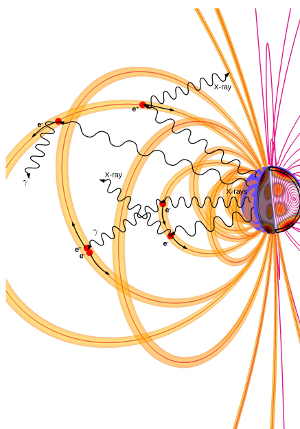|
|  |
Neutron stars are the remnants of the supernova explosion of massive
stars (Fig. 1), and they are the most compact stars in the
universe. Their mass of one to two solar masses is confined under the
influence of their own gravity to an almost perfect sphere of about 10
km radius, i.e. the density inside a neutron star exceeds even that of
an atomic nucleus. These conditions cannot be produced on Earth. If we
want to improve our knowledge of the matter and the interactions
between the smallest constituents of matter such as neutrons, protons,
electrons, muons, but also, hyperons and quarks, we need to understand
the structure of neutron stars (Fig. 2). In this respect a particular
class of neutron stars called magnetars plays a special role.
Magnetars are the strongest magnets in the Universe. Estimates
indicate that they could reach magnetic fields with a strength at the
surface of up to some 1015 Gauss, which would make them about 100
billion times stronger than the strongest magnetic fields on the solar
surface (to say nothing of Earth). Sometimes magnetars produce giant
gamma-ray bursts, which are thought to arise from a catastrophic
reorganization of their magnetic field. During these outbreaks
astronomers observe a number of discrete frequencies in the associated
X-ray spectrum, which should come from pulsations of the star itself
according to established models. Therefore, these observations would
be the first evidence of oscillations in neutron stars and one could
use them to study their structure. This asteroseismology would be
analogous to seismology on Earth or helioseismology on the Sun.
The magnitudes of the observed frequencies fit well with torsional,
elastic shear oscillations in the crust of neutron stars. As the exact
pulsation frequencies depend on the properties of the matter in the
crust, these frequencies can tell us about the state of this
matter. But not all pulsations can be explained as shear
pulsations. The frequencies of the so-called Alfvén oscillations
caused by the magnetic field are in the observed frequency range as
well (for magnetic fields from 1014 to 1015 Gauss). These Alfvén
oscillations are not confined to the solid crust, but also provide
information on the composition of the liquid core of the neutron star.
In his PhD thesis at the Max Planck Institute for Astrophysics,
Michael Gabler together with colleagues at other institutions
developed a model that combines these two types of pulsations. The
properties of the coupled system can be investigated by relativistic
magneto-hydrodynamic simulations. It turns out that the coupling
strength and the resulting magneto-elastic oscillations depend on the
magnetic field strength: For weak magnetic fields shear oscillations
dominate are present in the crust, while for strong fields Alfvén
oscillations dominate. In the interesting range of about 1015 Gauss,
the purely elastic pulsations in the crust are absorbed very
efficiently by the Alfvén oscillations of the core. Therefore, only
coupled (i.e. magneto-elastic) pulsations, whose frequencies are in
good agreement with the observed values, can explain the observations.
In order to observe the oscillations, they have to modulate the
intensity of the electromagnetic radiation emitted by the neutron
star. A model (Fig. 3) describes the coupling of the magnetic field
inside the star to the field of the magnetosphere around the
star. Because of the coupling, the external magnetic field oscillates
as well, inducing very strong electric currents in the
magnetosphere. Photons emitted by the star or in the gamma-ray burst
are scattered by the electrical charge carriers (electrons and
positrons) of these currents. This resonant cyclotron scattering is
very effective and can explain the observed modulation of hard X-rays,
as has been shown in Monte Carlo simulations. The X-ray or gamma-ray
spectra, which were calculated using the core-crust-magnetosphere
model, will be very useful for the design of new X-ray observatories .
Note
For his dissertation "Coupled core-crust-magnetosphere
oscillations of magnetars" Michael Gabler received the PhD Award 2012
of the Excellence Cluster Universe in the category "Theory".
Michael Gabler and Ewald Müller
References
PhD thesis, Michael Gabler, TU München, Nov. 2011
Gabler, M., Cerdá-Durán, P., Font, J.A., Müller, E., Stergioulas, N;
accepted by MNRAS ,
 arXiv:1208.6443 arXiv:1208.6443
Gabler, M., Cerdá-Durán, P., ,Stergioulas, N, Font, J.A., Müller, E.;
MNRAS 2012, 411,
 arXiv:1109.6233 arXiv:1109.6233
Gabler, M., Cerdá-Durán, P., Font, J.A., Müller, E., Stergioulas, N.;
MNRAS 2011, 410L,
 arXiv:1007.0856 arXiv:1007.0856
|


